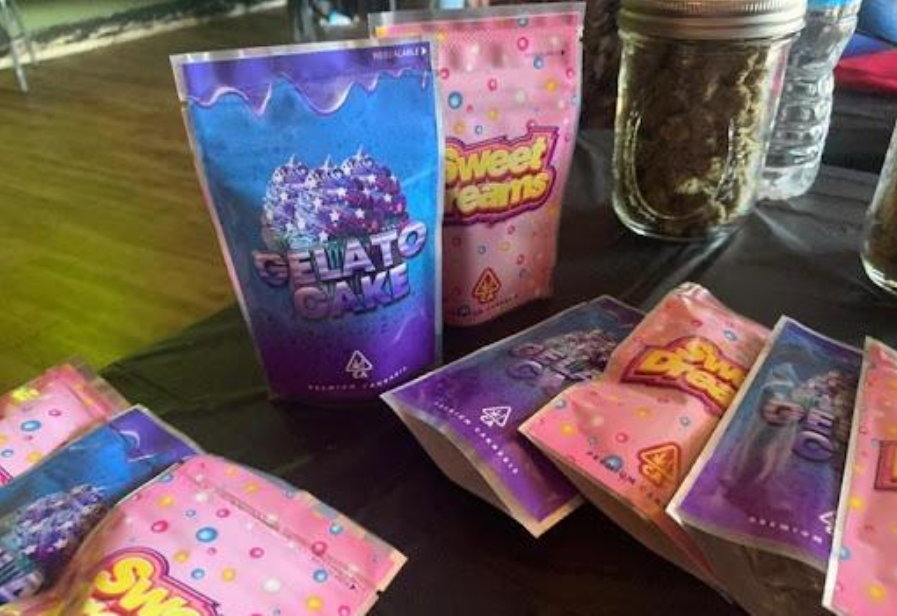

Whether it’s cartoon characters on the legacy market or unsustainable industry practices, cannabis packaging needs to be re-imagined.
You might be noticing a trend that has infiltrated the cannabis space for quite some time now: problematic packaging. The problem is 3-fold.
First, there’s the issue of excessive waste from the packaging of regulated cannabis products. Child-resistant and tamper-evident packaging is mandatory for cannabis in most states, so most brands use extra plastic in order to achieve compliance. The result is a massive amount of single-use plastic and other packaging waste (just think of the amount of vape cartridges!).
Next, we have problems in the grey market where clandestine sellers use counterfeit packaging that imitates regulated cannabis products from other states (usually California).
Counterfeit dispensary packaging has been used in the underground market for years. Most people just want something regulated, and how can you blame them?
As selling cannabis has become much easier, so has packaging and marketing it. However, when you can literally buy dozens of varieties of empty bags that look like real, regulated cannabis packaging, a big problem arises— counterfeit packaging.
This brings us to our final issue. Copycat packaging that capitalizes off the brand recognition of similar non-cannabis products, often including blatant copyright/trademark infringement. This problem is especially concerning because it may increase the risk for accidental consumption (potentially in children).
In Buffalo, the grey market is booming, and everybody wants a taste of it before regulations crush those without the capital to back their businesses. Although this fast-paced,
Even when dosages are labeled, they’re very rarely accurate or reliable. In most cases, you have absolutely no idea how many milligrams of THC these products contain.
The bottom line is that sellers have a duty to be honest right now. If you’re not an edible scientist or you can’t calculate the exact milligram amount in high-demand marketplace has helped legacy market growers take the spotlight in an effort to legitimize themselves, the reality is that too many people are trying to jump into the industry with little desire to take consumer safety seriously.
To underscore this, I’ll take you back to when I first started to taste the sour reality of unregulated cannabis packaging. One bag I came across was labeled “Cheetah Piss,” and it featured a glowing crimson cheetah. Another “exotic” strain, “Banana Milk’’, was packaged in a bright yellow bag with a bunch of cartoon bananas inside of a white mason jar. It just felt wrong.
Cannabis is not a sneaker brand, and as such it should be treated with the same respect and integrity as any other adult consumer product. There is a reason that Camel stopped marketing their cigarettes to children. Yet, I still see Buffalo-based weed startups using cartoons in their logos, completely sending the wrong message to our youth and about our cannabis community as a whole.
The utmost priority of anyone selling cannabis should be the safety of their consumers. Not only is it lazy and disingenuous to buy imitator packaging online, but it also makes me uncomfortable that the product I am buying is hidden behind an opaque bag. Many buyers are drawn to the most important aspects of any product in any industry: the logo, the packaging, and the brand experience.
The experience is exactly what some vendors go for, and I’ve seen it on multiple occasions, too— infused Bob Ross cereal, Stoney Patch gummies, Fritos, Cheetos, Pringles, Wonka bars, Twix, and Snickers. These copycat packages5 for edibles are a nightmare from a safety standpoint, as they could easily be mistaken for the actual non-infused product.
Dr. Anthony Degelorm, an emergency medicine and toxicology pharmacist from Florida said that the State’s Poison Control Center has seen an increase in cases involving accidental exposures to THC. He mentioned that packaging may be contributing to the problem.
Consuming edibles is a serious undertaking, especially for someone with little experience or a lower tolerance to THC. To make things worse, consumers often can’t rely on grey market labels to give them a recommended dose or serving size.
For the edibles you make, warn us and don’t slap some fake packaging over it. If you’re selling flower, put it in a mason jar or other transparent container so we can see and inspect the product, don’t hide it behind a colorful bag.
It is getting so egregious that even local businesses are getting tangled in the fight for their own intellectual property. We seem to forget there was a vaping-related health crisis tied to products that used copycat packaging. While we can certainly point fingers at bad policies like prohibition, keeping children and the community safe is not a tall order. It’s the bare minimum.
Related: $5 Million Worth of Marijuana Seized at Border

